Press play, listen, scroll through the transcript, and take yourself back to Soho then with the images in this photo-based podcast...
Transcript
Clare Lynch: Welcome to episode four of the Soho Then photo-based podcast. I’m Clare Lynch, audio producer and Soho resident. This programme consists of six, themed episodes released monthly from December 2018 to May 2019. Each episode has a corresponding collection of photographs that you can scroll through as you listen.
In this episode we explore the topic of clubs and late-night establishments in Soho’s past. Dorothea Phillips is our guide with contributions from former and present-day residents and workers sharing their memories of Soho from twenty or more years ago.
--
Dorothea Phillips: My name is Dorothea Phillips and I was born on September the 5th 1928. I’m therefore rather antique! I came to London on the 5th of September 1949 with two people I’d been in university with. And they introduced me a) to the Lamb and b) to the French House. So on the 5th of September 1949, I was literally in the French House and first met Gaston, whom I adored of course. And he had a lovely habit of actually twirling his moustache and saying, “I am not actually a Belgian, I am French.”
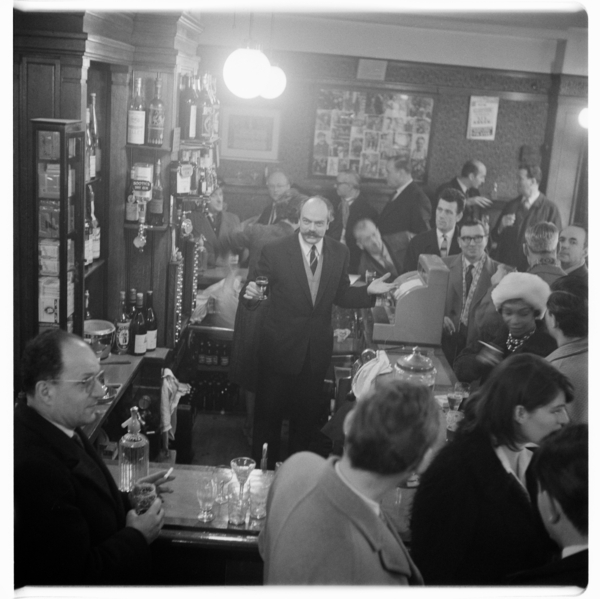
I went the following Monday to do my first job, which was in ‘rep’, God bless us. And I went from various places right around the globe really. Well, around the globe being this country. And then eventually, come the dawn, in 1954 I suddenly got a job in Under Milk Wood.
I have to say that in between, when one wasn’t working, I either taught or I served behind the bar or I cooked. Because I couldn’t afford to be out of work, because in those days they didn’t pay all that much. I mean, for example, I did a play straight on top of Under Milk Wood and I was the leading character, it was T.S. Elliott actually, and I literally was being paid £18 a week.
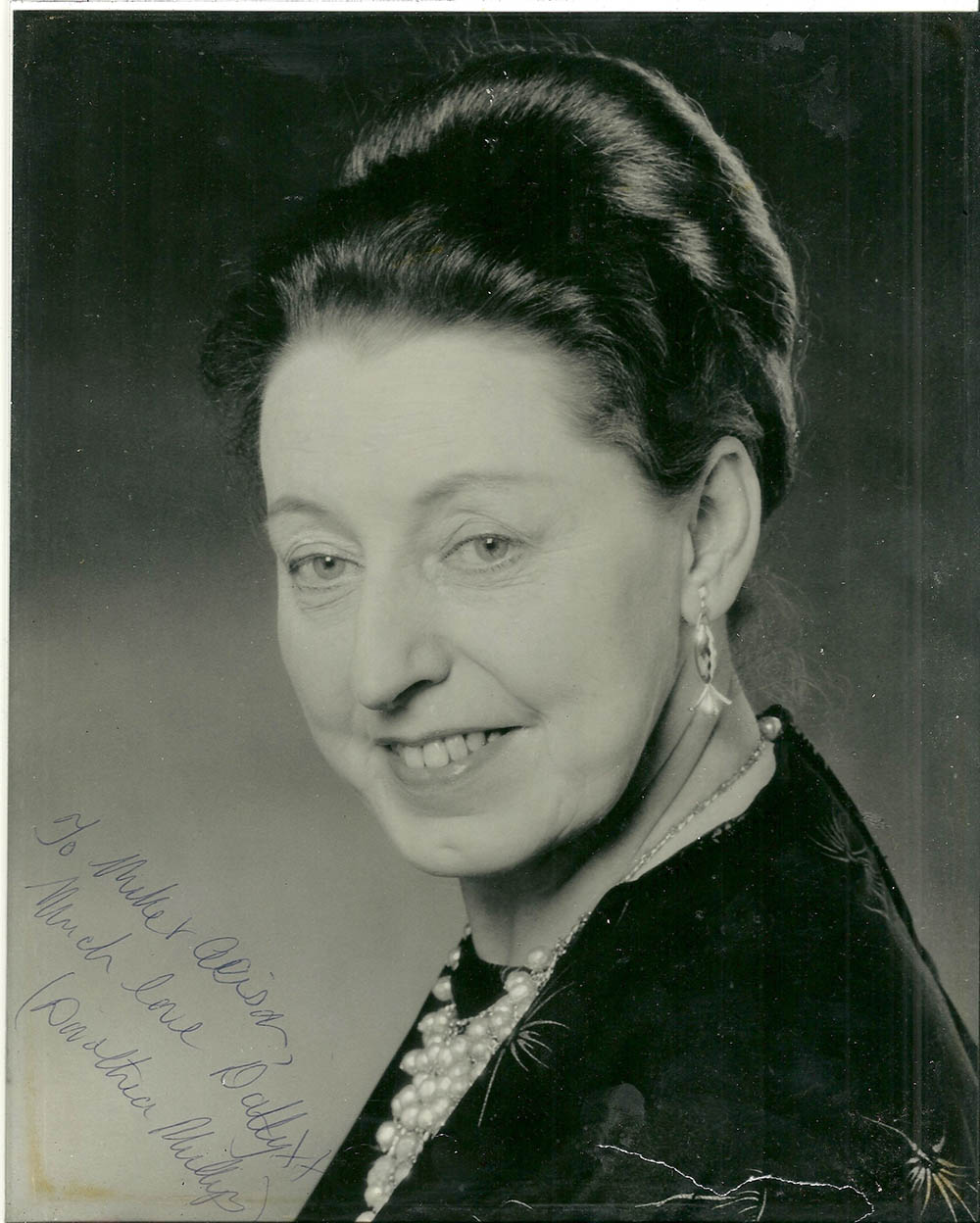
Lesley Lewis: My name’s Lesley Lewis, I’m 63, and we’re at the French House. I was offered a job making costumes and doing choreography for the Carnival Strip Tease club, which was in Old Compton Street. And that was 1979.
Michael Dillon: My name is Michael Dillon, I am 74 I think, or there abouts [laughter]. We’re in Gerry’s Club, 52 Dean Street. A friend of mine, whose name is Martin Curran, he said to me one day “Shall we go to Soho?” and I said, “Yeah”. He was 19, I think, and I was 15. I knew about it, of course, heard about it. He had a car, and we parked in Soho Square. And we went to the Coach and Horses and had a bottle of light ale, I think it was. I was dead chuffed, looking at everybody, weird, looking past us they were, then. Seems quite normal now.
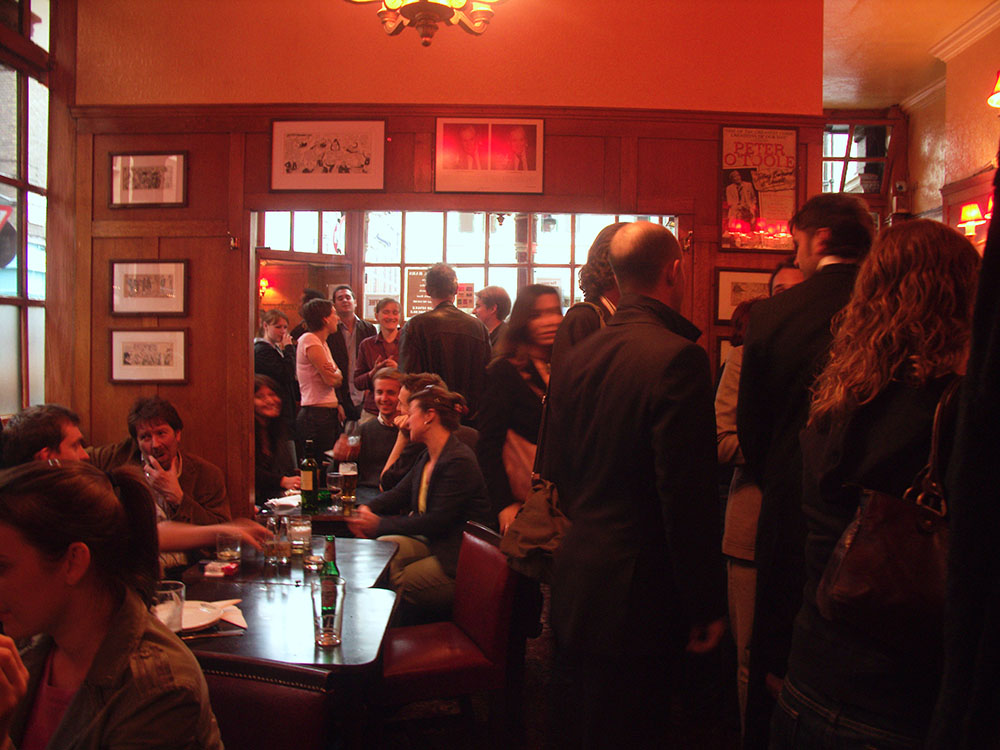
And I thought, “I like this place” and I kept coming back on my own. Not to any bar, just wandering. And then when I was about 17, I think, I thought “Well, I’ll have a drink.”
Dorothea Phillips: Well the licensing hours stopped either at 2 or 2.30 and started again at 5.30. So, of course, there were millions of clubs around the place. And what used to happen on a Sunday was even funnier because they used to start at 12 and finish at 2. Then there was a terrible hiatus so we used to pile into cars and find clubs nearby. And we all drank in the same places, and all the places to drink in were down in Soho in those days.
Armin Loetscher (Sweetie): Everybody used to come to Soho. That’s where you want to drink ‘til 3 o’clock in the morning. There were au pair girls and all the catering people used to come here – German, Swiss and Austrian and French…
Michael Dillon: When I started my engineering business in 1972, I used to take a lot of clients out. In those days, of course, after the restaurants close at 3 o’clock, you need a place to go to take clients and that sort of thing. And I belonged, at one point, I think to 36 afternoon drinking clubs. Crazy, really.
Well, they were for different people, certain clubs that you could fit into. I can’t remember their names but there were loads of them. In fact, there were 271 afternoon drinking clubs in the Westminster Council district, until they changed the law.
Lesley Lewis: Lots of places, we weren’t allowed in because we were to do with strip tease. And certainly we would never, not because we weren’t allowed to come in here, but we would never have come into the French House.
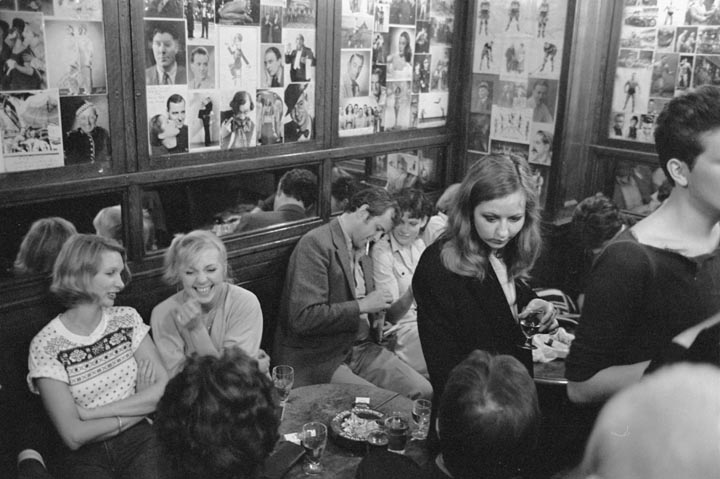
We would go to, there was a little club up the road, that you knock three times. A little door would open and if they knew you, they’d let you in. And that’s where most of the girls went. It’s called the Scene Arts Club, that one, I think that was up Greek – was it Greek or Frith? I think it was up in Greek Street. They were trying to make it out that it was a fancy club, when it wasn’t. It was a really sleazy joint upstairs. There was a little club above the Cambridge we used to go to as well, years ago.
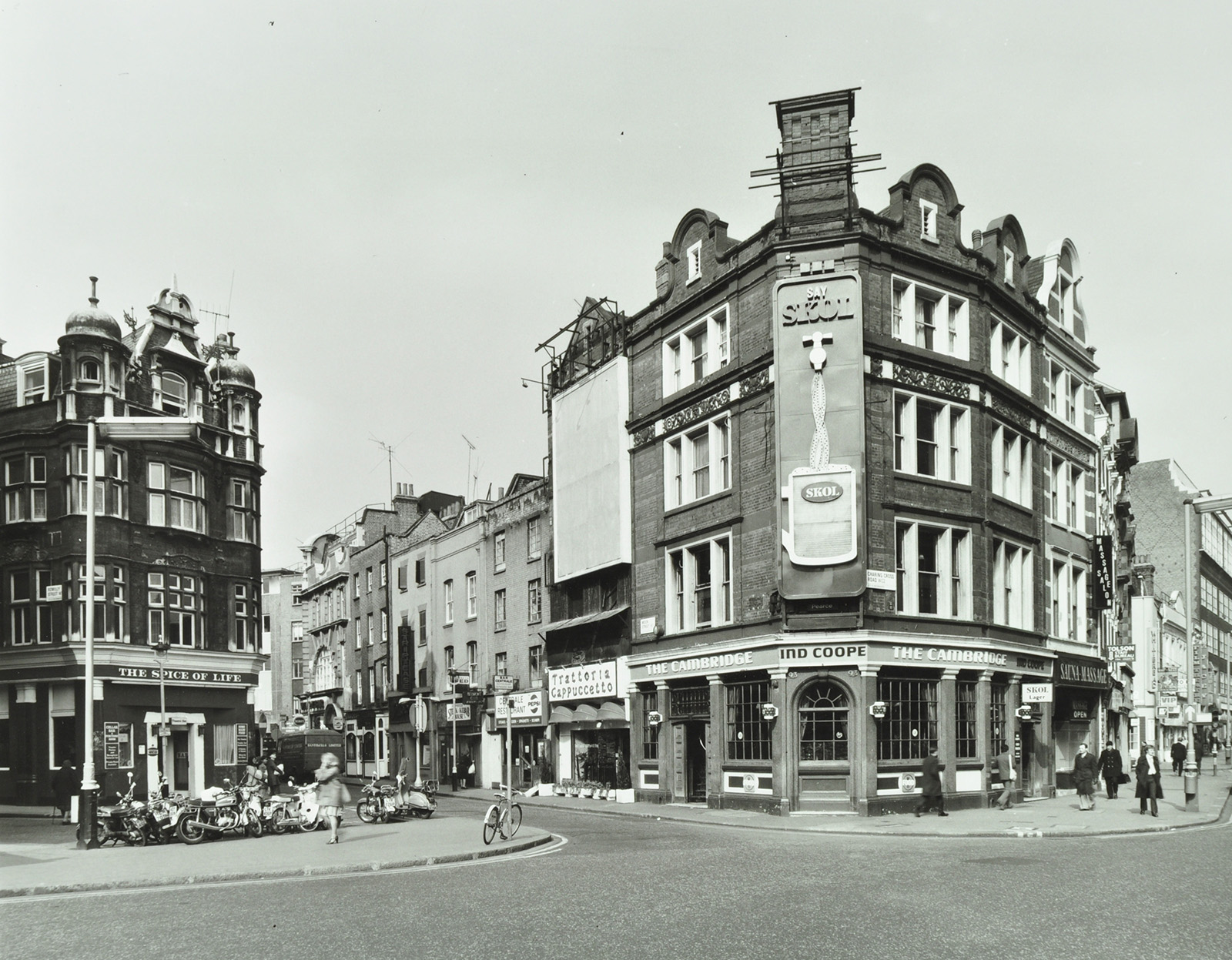
Dorothea Phillips: There was the Music Box, which was in Panton Street, which I knew very well because during one of my times off work I actually was a cashier in the restaurant next door a) because I spoke French and b) because I could count. [laughter] Then there was another club, well there was of course the Colony which everybody knows about…
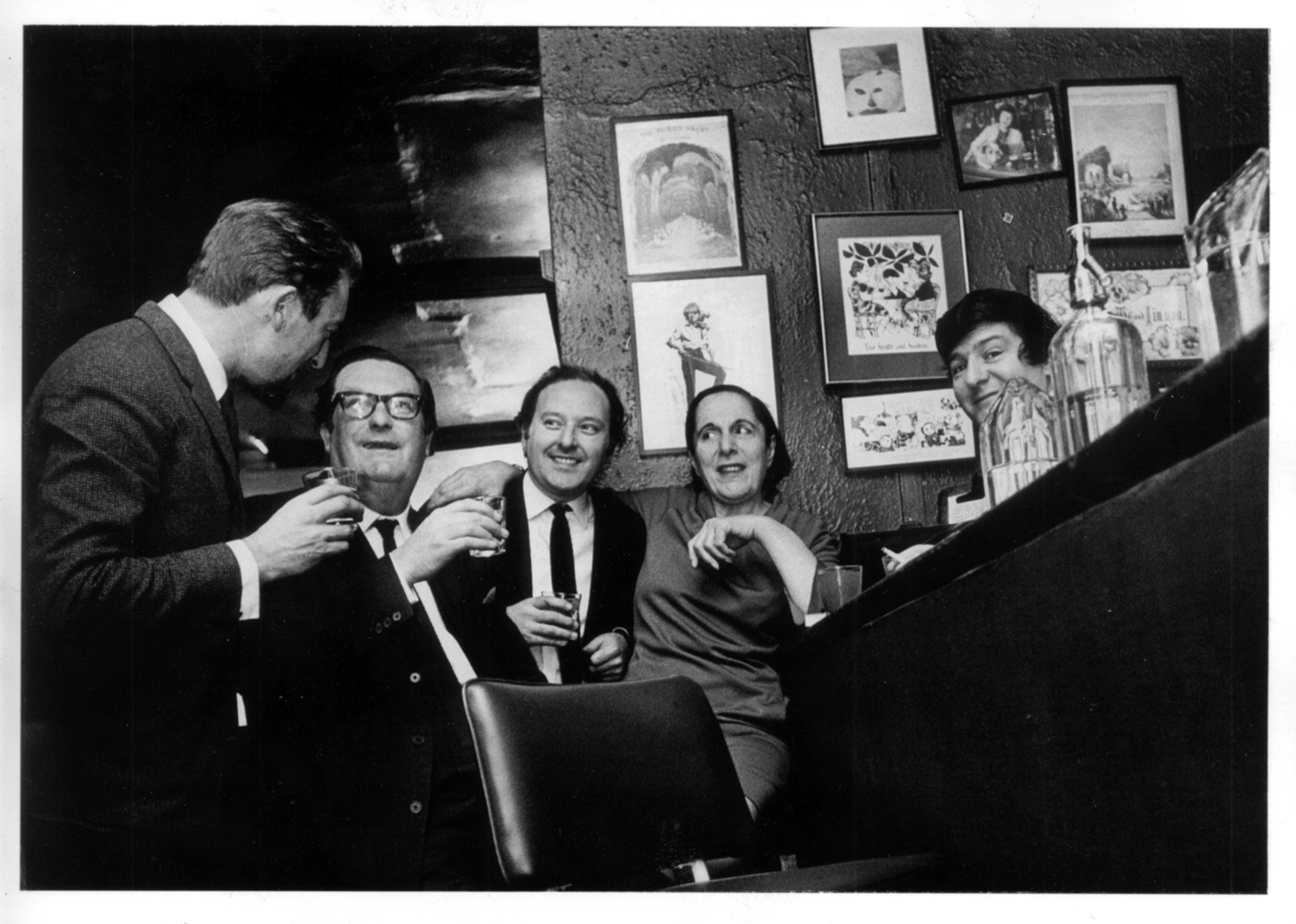
Michael Dillon: Now take the Colony Club, Freddie Saville was a member there. That was a hell of an experience, it really was. I met Muriel and we had a bit of an argument. I didn’t know that she was ferocious or whatever. I didn’t give a shit anyway. And she pulled a cigarette out of my mouth and tore my lip, which I was not too pleased about, and I went right to the end of the bar and I said “I’ll have a bottle of champagne.” I think it was £11 then, a bottle of champagne, 1970 I think. Ian Board’s behind the bar and I said, “Would you mind passing a glass to that beautiful lady at the end of the bar, Muriel?” And she said, “Oh, thank you.” “Come here, cunty,” she said. And she asked me my name again, and “blah blah”, ‘cause I’d filled the thing in. And we got chatting away and right as nine pence.
But people, well they feared her, which I couldn’t understand. I mean she had a look, well she’d look at you … but I liked her.
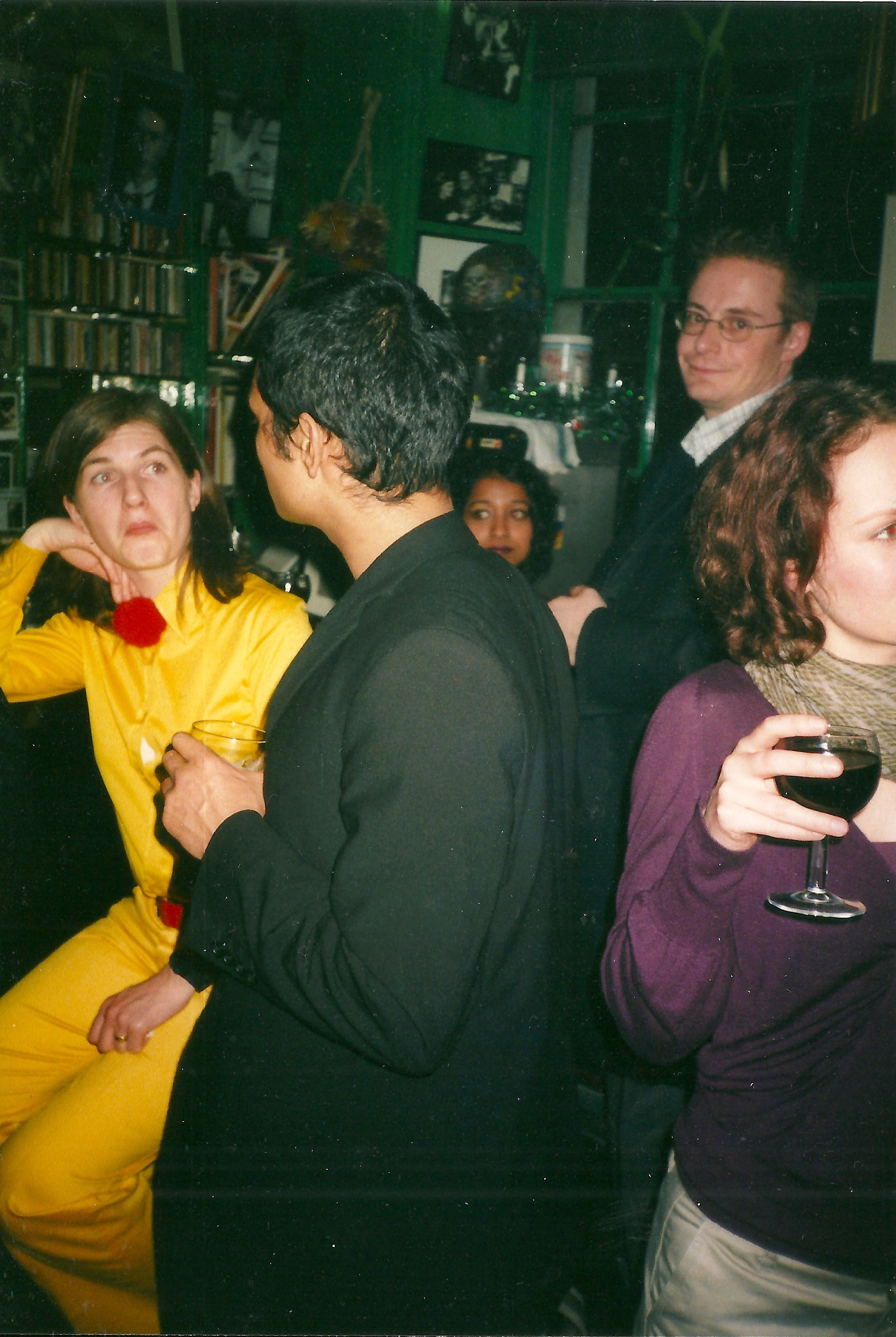
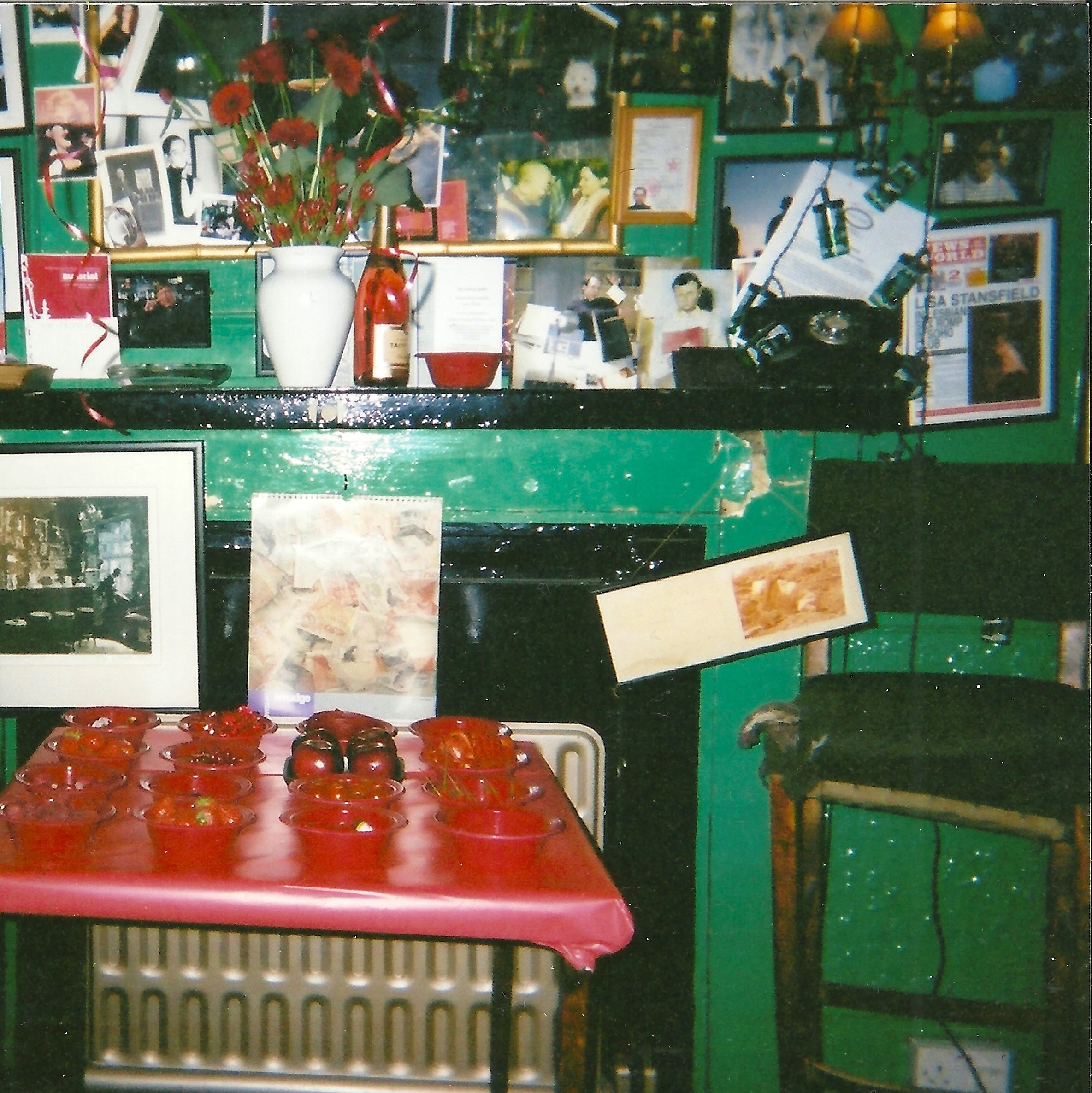
Dorothea Phillips: There was one, ha ha, the one what I used to run called the... well there was two I used to run, actually, three now I come to think of it. One was the Irving, then there was Kismet, the so-called Iron Lung, which was opposite the Arts Theatre, and then there was the Buckstone, which I ran at the last moment because I hold a London license. I have a law degree and they thought I was full of probity – well, I am, I suppose, I’m very reliable.
David Miller: In D’Arblay Street there was a little club above a sex shop and it was called the Hogarth Club. And it was run by a friend of my father’s, a lovely chap called Harry Schaeffer, who was an old tailor who’d gone into the drinking game. The barmaid, Doris, was about 5 foot and about 5 foot wide, and she was an old Windmill girl, lovely girl, full of stories. Get her to have a few beers, she’d still kick her legs up. And his stepson was Jeremy Beadle from ‘Going for a Laugh’ who was always in there with all his celebrity friends and everything. We would always just go in there, police used to go in there, cons, villains, judges, everyone was in and out of these little drinking clubs. Just the way it was, everyone got on with it really.
All the market boys went there, it’s local. They can walk down there, have a couple of beers, go back to the stalls. And all the film boys… It was a private club, you couldn’t just walk in. You had to be a member, and vetted and everything. Which I don’t think was much of a vet. You’d come in, “Yeah, you got the money? Ok, you can come in… “So and so says you’re ok.” That’s the vetting, as far as I know. [laughter]
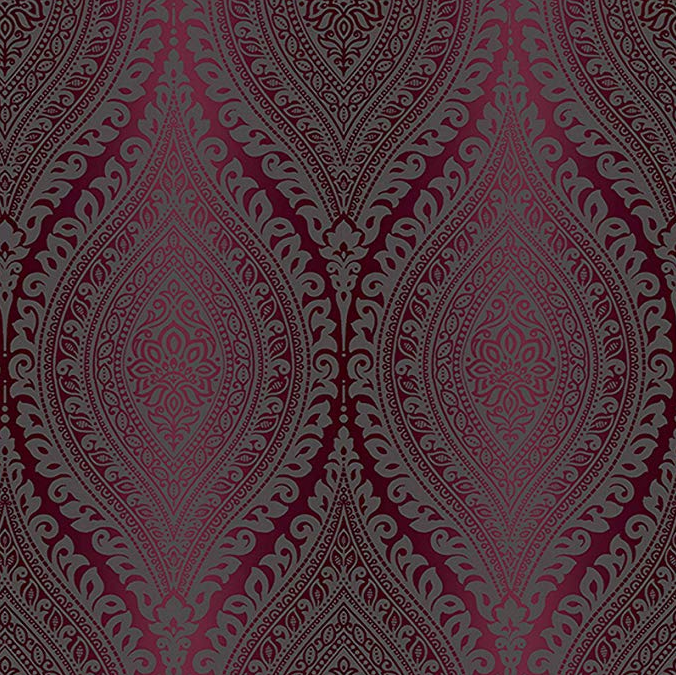
Dorothea Phillips: Kismet had that terrible wall paper, you know – dark red with a goldy pattern on it, you know … because an Indian gentleman had originally owned it. And in the cops and robbers bar, there was carved in the ceiling a circle of moons and stars. They used to advertise “Dance beneath the stars at the Kismet”. Well there was no dancing, darling, a lot of drinking went on obviously. And it was cops and robbers in one bar, and actors in the other.
It was very well run, actually, run by a lady called Mary. Mary dear, I won’t say what Mary used to say because it’s full of expletives. And she once said to me “Oh, I never fucking swear, love.” And I went, “Oh, no.”
And people like Francis Bacon used to come in and he kept a whole box of champagne for his friends. Which would live in the very, very cold cellar under the road. This club went through – one bit was on one road, the other bit was on Great Newport Street. And everybody drank an immense amount but nobody ever seemed to get pissed.
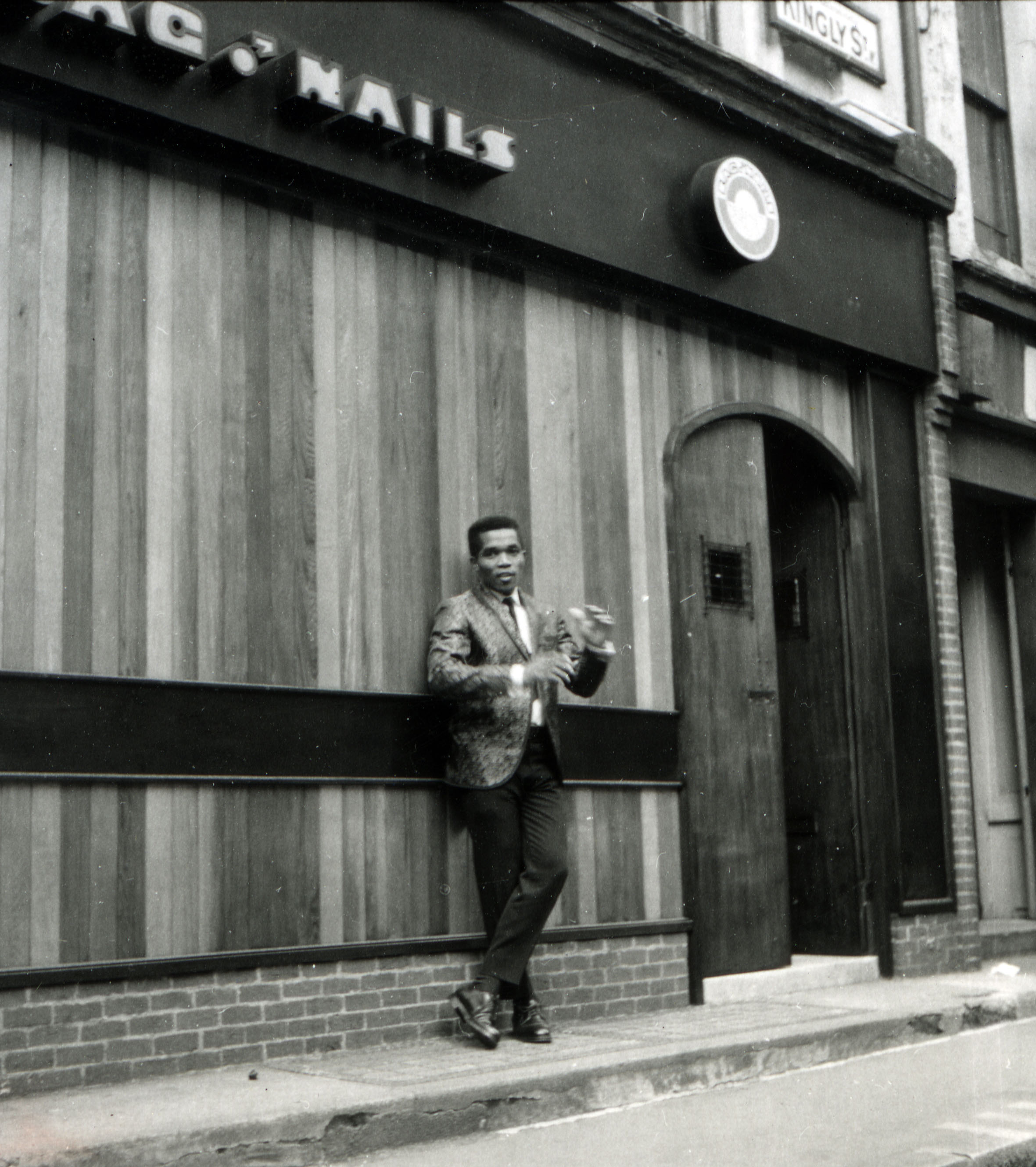
Tony Phillips: I went to loads of little clubs, I went to the Whiskey-a-go-go and there was another one downstairs, the Flamingo, something like that, then they had Bag o’Nails, Carnaby Street, it was just a club, a night club. You had the 100 Club, in Oxford Street, and then in D’Arblay Street – La Poubelle, little club, it was like a restaurant upstairs and downstairs, basement club. A little bit seedy, but it was good. You know, it was nice. No one ever… you had a good night out there. But it’d be an all-nighter place. Dancing… just dancing and, I think everyone was taking blues or whatever to stay awake, but enjoying themselves … it was a fun club.
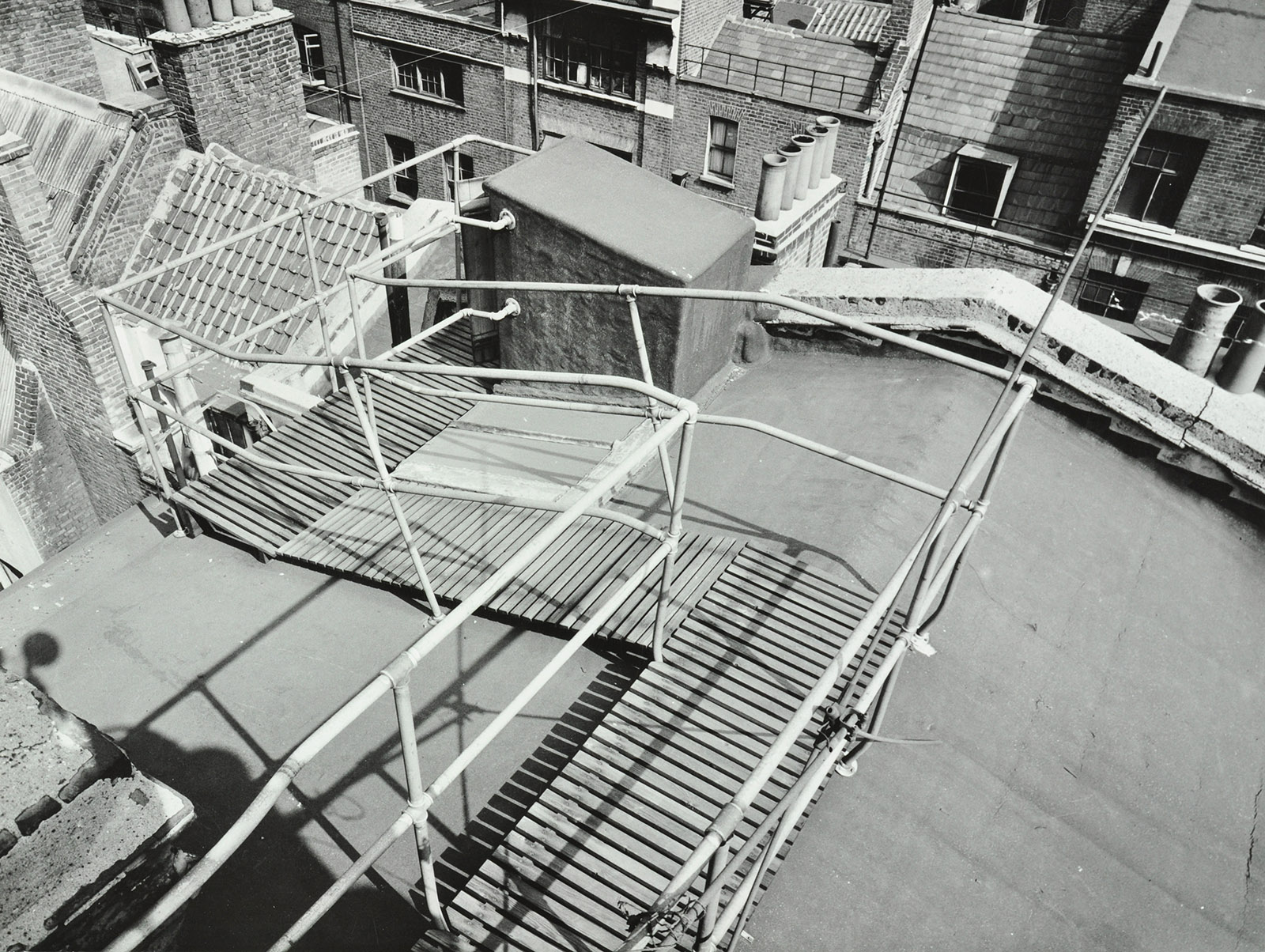
Wayne Kirvin: There was a fire escape that used to go out of the back of the Discotheque, used to go over Rupert Court into where the Whiskey-a-go-go was. So when it used to get raided for pills, everybody used to get out the back entrance behind the pinball machine, and go over the fire escape and go into the Whiskey-a-go-go and vice versa. So you’d get all the Americans who used to go to the Whiskey-a-go-go – they had a big American following there from the air force bases used to come up to the Whiskey-a-go, and the Flamingo downstairs, and it would be the funniest thing you could ever see. You know, the police would go into one place, they’d be over. The next thing you know, another lot would come over to the other place. It was hysterical.
Anyway I got very friendly with a guy from Hackney. And he said, “Oh there’s a club, and it’s been closed for about a year or so. We want to get all the guys from Tottenham Royal, the guys from Barrow, to go to the West End.” And I said, “Oh, yeah, what’s it called?” And he said, “It’s called The Discotheque.” He said, “It’s completely empty but what we’re going to do is get all these mattresses and throw them on the floor, so it looks kind of like a French club.” And this was a guy called Peter Sugar.
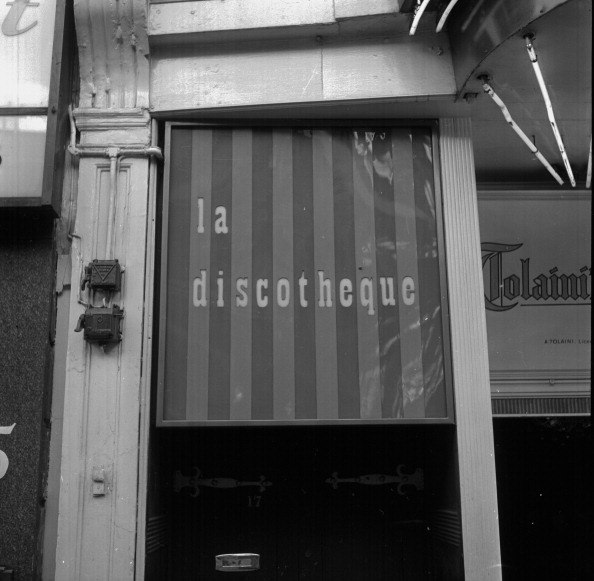
Anyway… so, I started The Discotheque and I complained about the music. And they said, “Well, you play what you think we should be playing.” And the landlord at that time had just died, his name was Rachman, and we had another landlord took over. And he said, “We’re going to do the place up.” So they did over the place a little bit better than it was. And they used to send guys down from ‘Ready, Steady, Go’ to pick out all the great dancers at The Discotheque on Wardour Street.
Michael Dillon: When I first came down the stairs, in 1971, I thought, “I’m in heaven, truly, I’ve found what I’ve been looking for… really…” And Bunny May and Sean Lynch had it then, in Shaftsbury Avenue, 81 Shaftsbury Avenue. Gerry was working in the Buckstone, and decided to get his own place for actors, really, actors then, it was all actors then. The club had been a club. It was bought from Wanda Ventham’s aunt, it had booths, as opposed to open like this. And very good food. Mary Swan was in the kitchen. She came in ’73 I think. The best Irish stew you’ve tasted in your entire life.
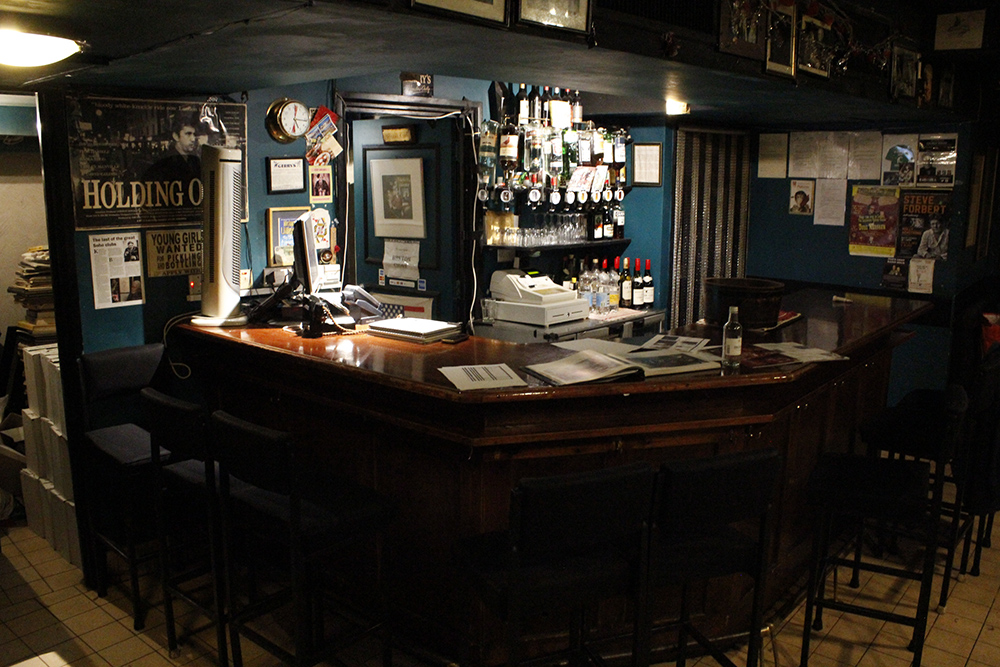
Well, Gerry’s Club opened at 12 o’clock in the old days, when I first joined. And closed at 3 and opened again at 5 o’clock til 11. Even though there were people coming in and I’ve been here, before I got the place, til 2 and 3 in the morning. But they kept being raided.
Armin Loetscher (Sweetie): I got raided a few times, selling things to non-members. You get a fine and they warn you. But, you know, it’s very hard.
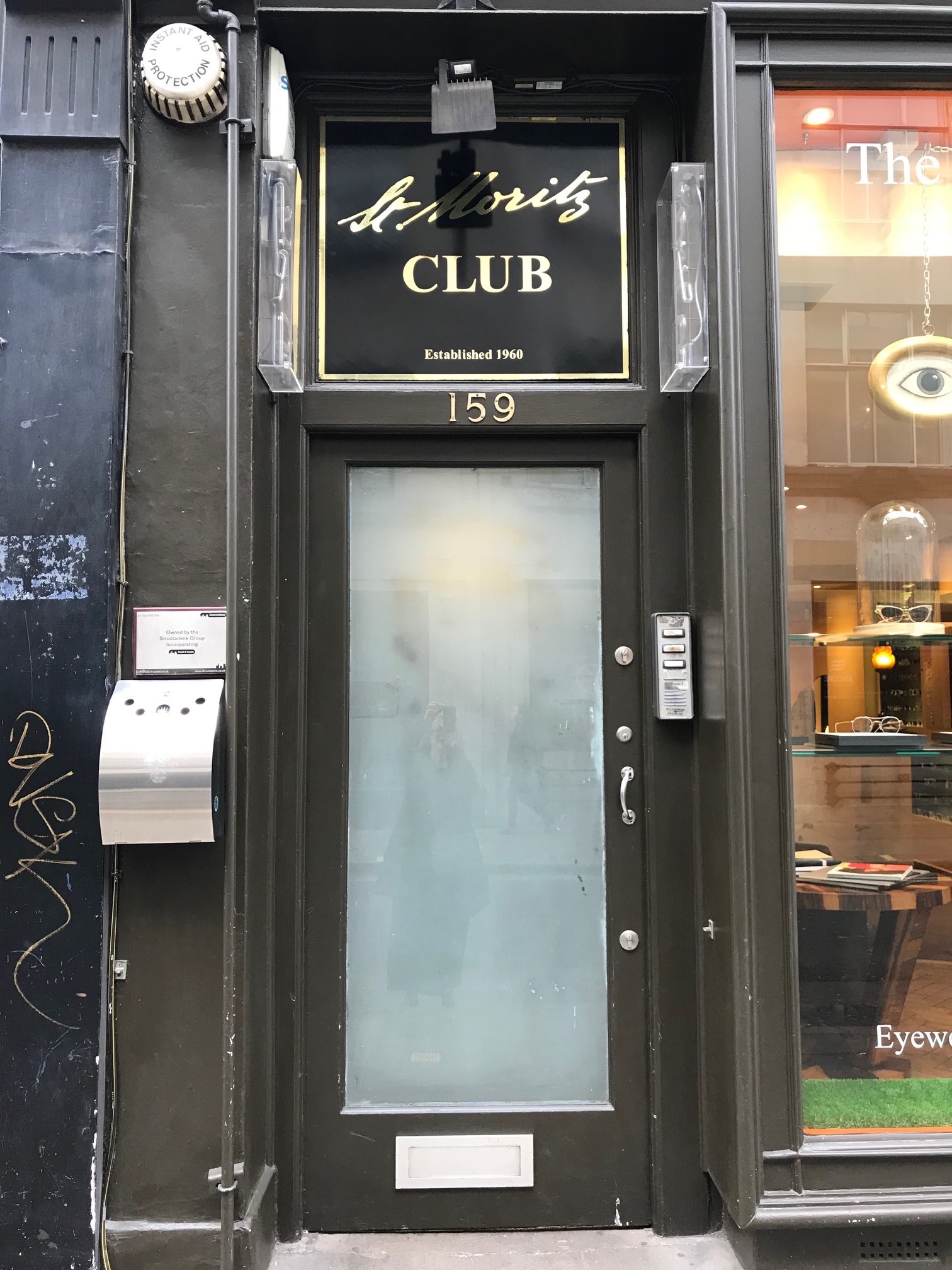
Dorothea Phillips: The Buckstone was slightly upmarket. Well, it was the ladies and gentlemen who were playing slightly larger parts. Occasionally stars popped in, just one down on the scale, do you know what I mean? Because the others went home in their limousines dear, to prepared food, if you follow me. Not that I ever did, but never mind.
So you went along these black railings and there was a very, very steep flight of steps going down. The back door opened. The stage door of the Haymarket theatre. And you went in to the right. And the first thing was there was a very large room with tables because it was a dining room really. Then they built another bar on the left and a small room to the right for committee meetings, I was on a committee. And you know, if anyone wanted a private dinner or something. So that was the Buckstone.
Lesley Lewis: But there were various sections to Soho then. There was the posh bits and the really grand restaurants and hotels. And then there’s the funny little bars ‘round the corner or the café underground or whatever…
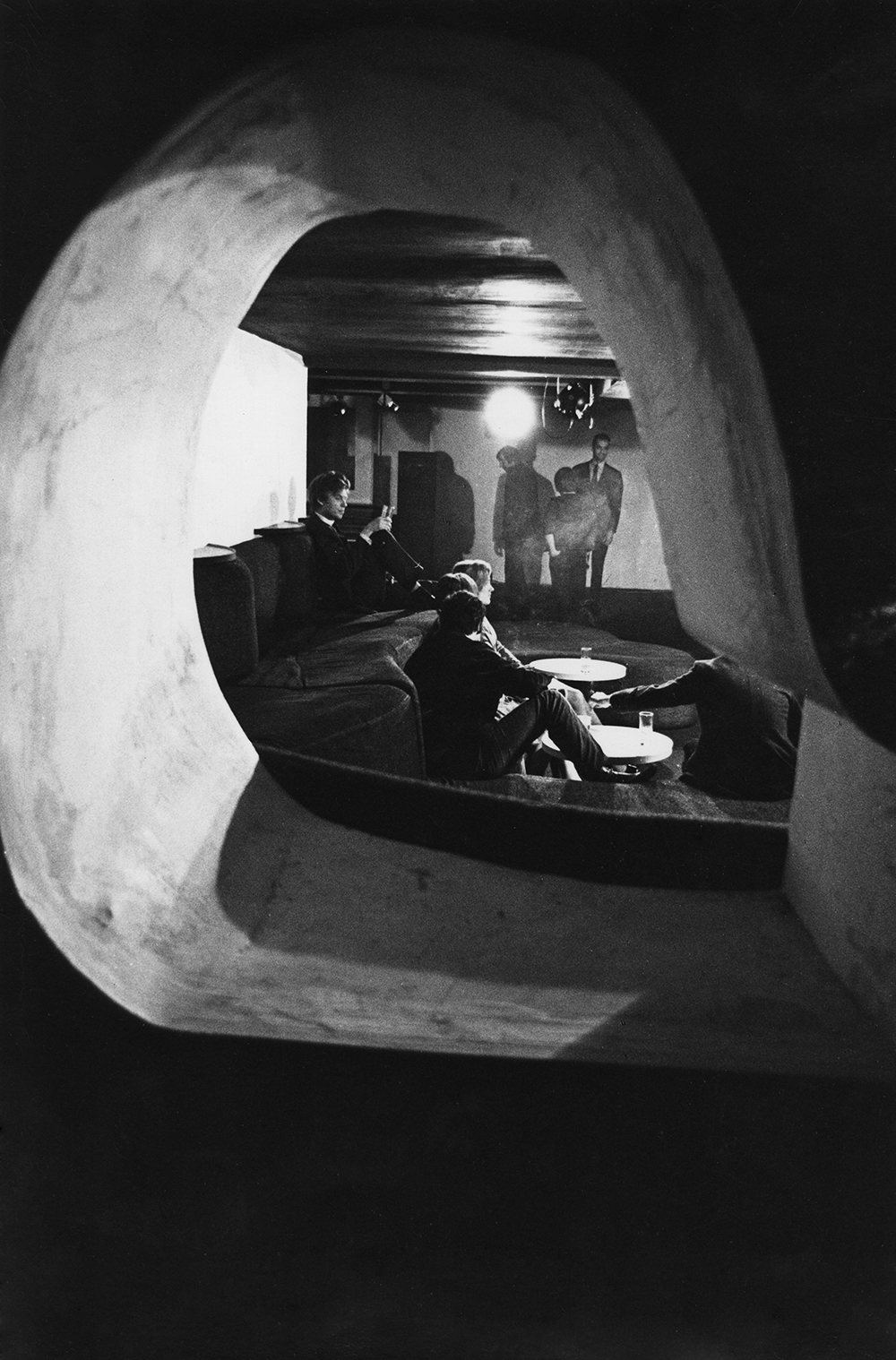
Armin Loetscher (Sweetie): My name is Arby Loetscher, I was 80 this year, and I’ve lived in Goodge Street and Wardour Street. I’ve been in London since 1959. There was first only the restaurant, St Moritz restaurant. Then the boss opened up a club. That’s where all the Swiss and German and everybody met. All the catering people. It was only one room and then after, it was so busy, we broke through –159 and 157 used to be three cellars. And then in ’67 I took over the club from my boss. There were always live bands. 157 was like a beer cellar, we used to have bands there. I had a piano there, I had all the instruments.
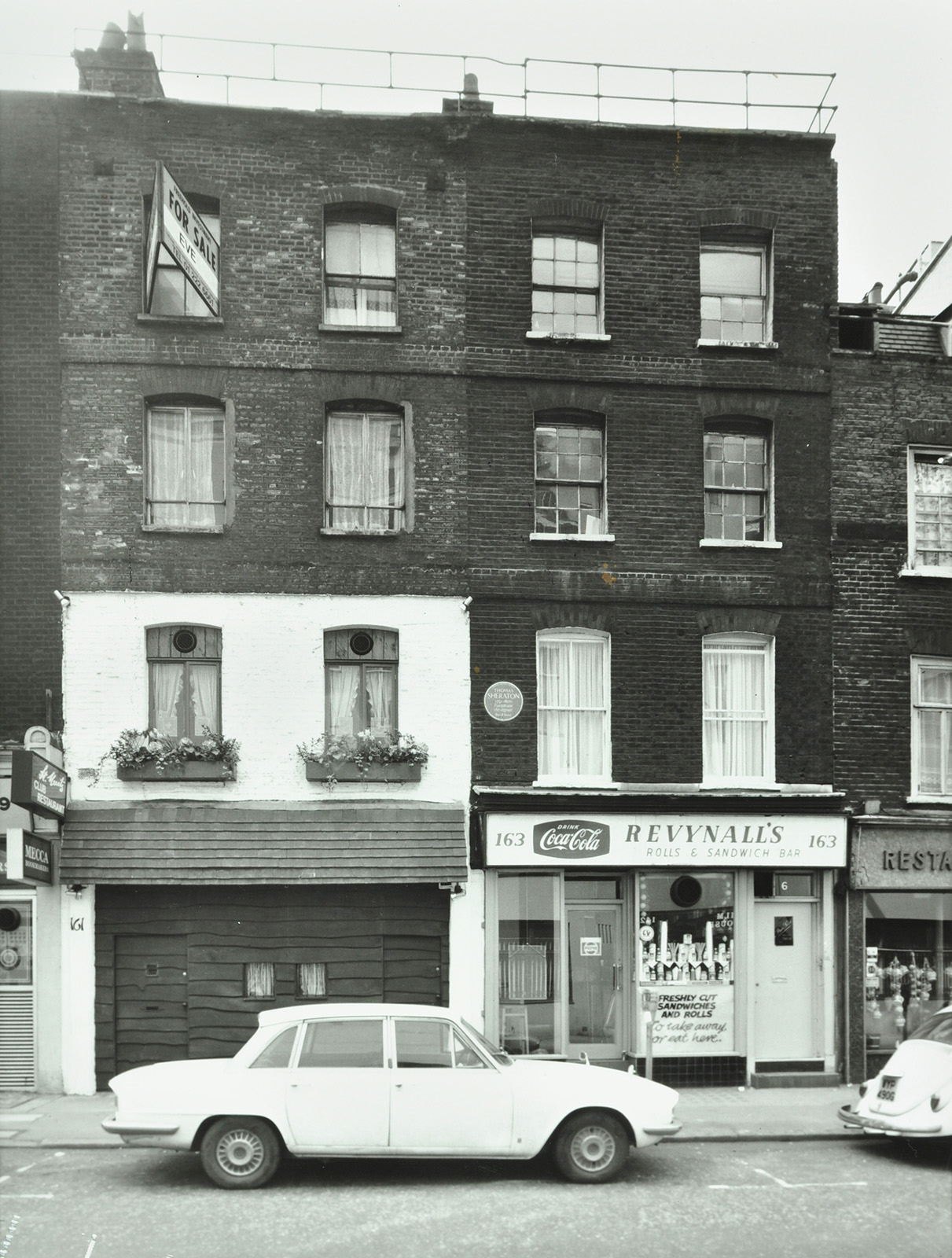
Michael Dillon: Gerry’s Club is like stepping back into another age. It’s a small club – with pictures of present and past members, a lot of them dead unfortunately. It’s a sort of greenish wall, floors off-white, tiled… tables and chairs, and the bar – it was, at one point, mahogany, I think. Somebody described it like Cheers – where everybody knows your name. It’s small enough. And people talk to each other here, there no little groups, everybody talks to each other. They’re all like one big unhappy family. [laughter]
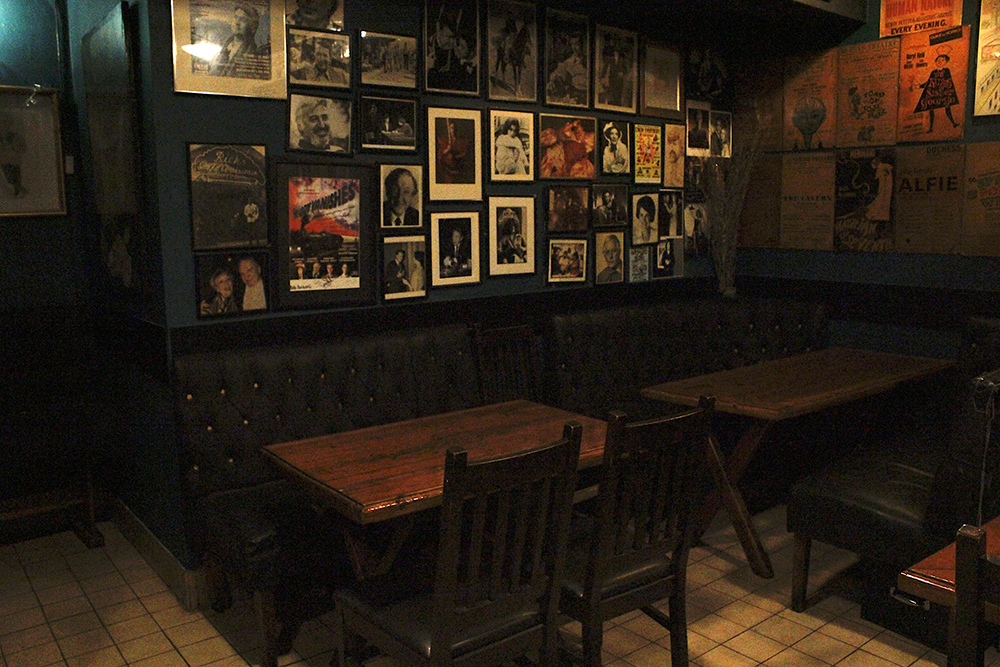
Lesley Lewis: And that’s what makes it special, really. It’s everything, all kinds of people, all kinds of nationalities, all kinds of food, drink and everything else. Mingling together, and somehow getting on.
Michael Dillon: A lot of writers came here. Journalists, a lot of journalists. Editors, lots of lovely actresses and um… I’ve got a picture here which I found the other day, I hadn’t seen for a while… that’s Keith Waterhouse, Sandy Faulks and myself there… in the club… no special occasion, just coming in.
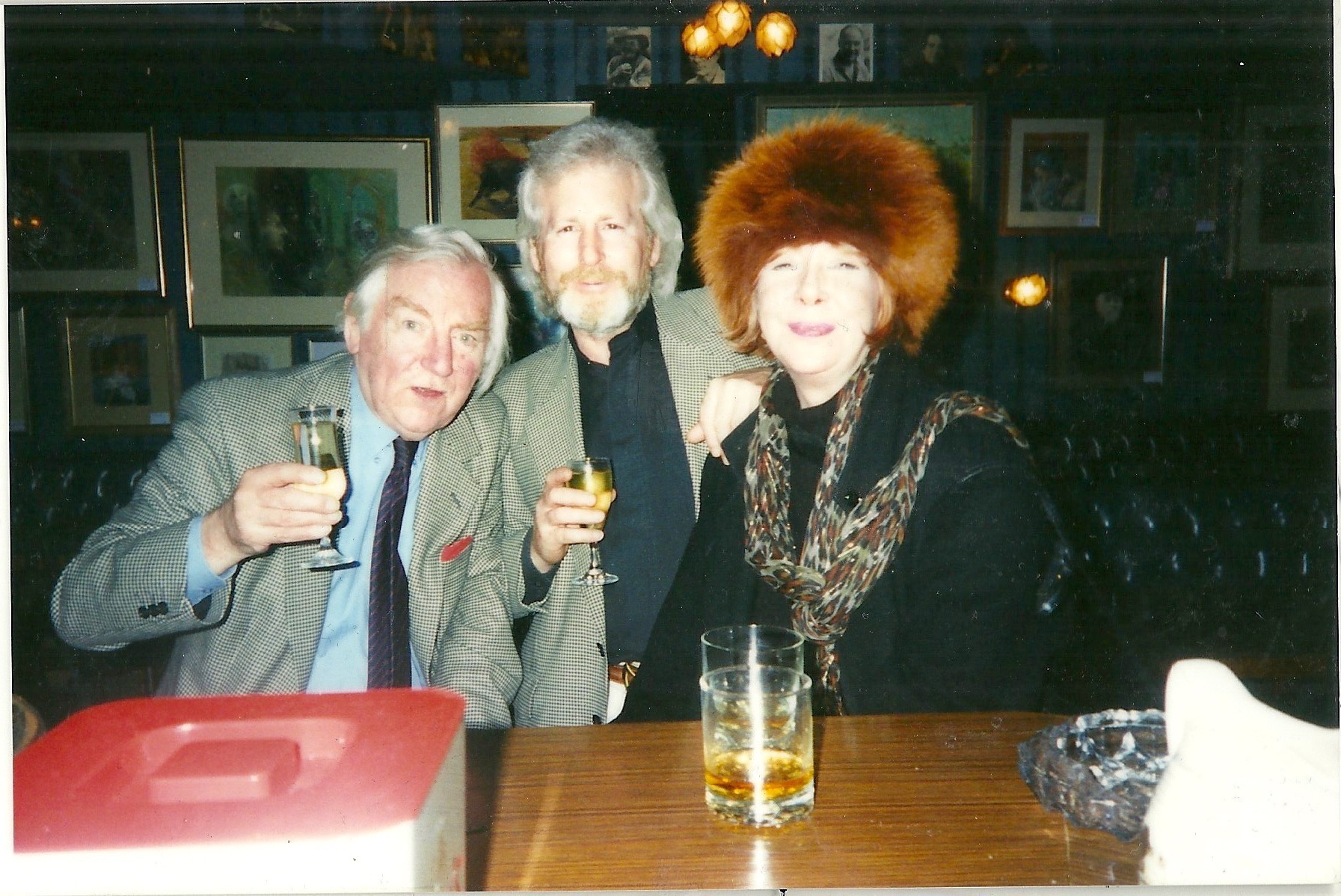
Sandy was a great journalist. She was a fashion editor with the Express, I think.
Armin Loetscher (Sweetie): And that used to be the newspaper. When the Swiss carnival, nine crazy nights… We had our own carnival band, 16 of us, everybody hired an instrument from a friend… and we went from here down to Piccadilly, round Piccadilly, then to the Swiss Centre, played and came back here. We had trombone, bass, and drums, saxophone – I used to play the drums.
[singing] Alles fahrt Schi, alles fahrt Schi, Schi fahrt die ganzi Nation…
Michael Dillon: The ‘70s, were closed at 12 o’clock, unless they were a specialist club like Gerry’s. But even then didn’t have a license til 3 in the morning. But there were places that you could go if you were a waiter that opened at 2 o’clock and closed at 7 in the morning. And, of course, the Chinese had their own places that opened all night.
John Campbell (aka Ebbonknee): There was one called the Sunrise, which was on Long Acre, which was a morning breakfast place. So it opened about 3 as well, and it’d go on ‘til about 7 or 8. And so everyone who worked in nightclubs, you went down for breakfast, would go to the Sunrise. I mean, there was the Sun Luck, which was in Chinatown.
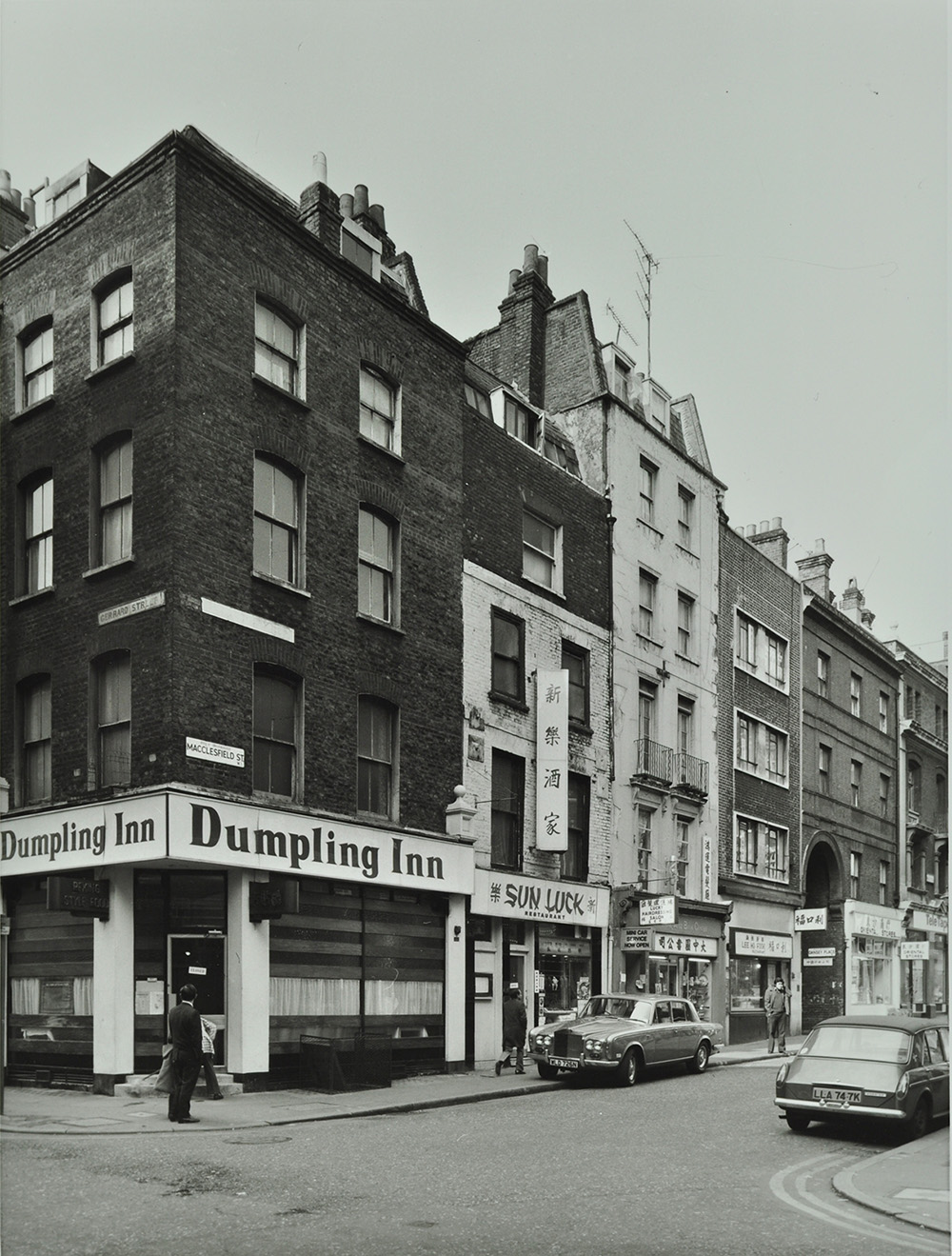
Well Peter Stringfellow always used to go there for breakfast after his club nights. But that was one of the places in Soho that we used to go to.
John Campbell is my name and my stage name is Ebbonknee. I came on scene at the end of ’81, ’82 and there was the Candy Box, which was on Kingly Street, and that used to be a late night club which opened at 3 o’clock in the morning for people who worked in nightclubs. So you’d get the waiters, barmen, owners of nightclubs – they would go down there. But then, of course, they’d take their friends there. So they could be ladies of the night, they could be drag artists, they could be East End villains, they could be Lords and Ladies, judges and all that, and everyone would just have fun.
Carl Snitcher: My name is Carl Snitcher and I was born in Cape Town, on the 6th of July, 1941. The understanding that Paul Raymond and I had in those days was that I’d joined the company as Chief Executive and Legal Advisor, so I had a particular function as an internal legal counsel to the company which was then involved in publishing Top Shop magazines and running theatrical shows. We hadn’t at that stage acquired any property so the property side came afterward, which then became Soho Estates. So when I joined the company that’s what it was, magazine publishing and theatrical shows.
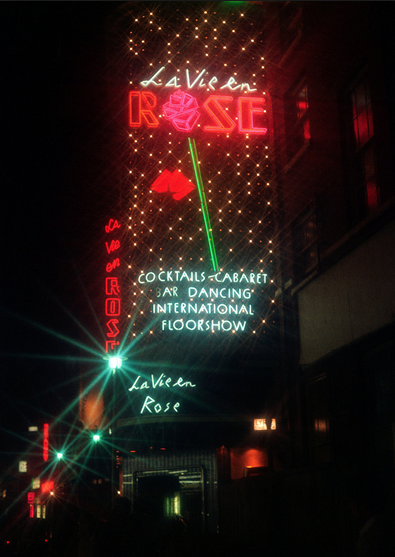
One of incarnations of the Windmill Theatre, we changed the name of the Windmill Theatre to La Vie en Rose. And that’s where Kit and the Widow worked and Ruby. It wasn’t a nude show. Kit used to call it ‘Luvvie’.
John Campbell (AKA Ebbonknee): Paul Raymond said, “We’re going to do this West End show, it’s going to be very lido style, very Moulin Rouge.” Because it was early ‘80s and there were all sorts of things but there wasn’t anything that was really ‘WOW’. So, he opened La Vie en Rose. The Windmill as it had come per say, the tableau vivant and all that, had come to an end.
Now, for La Vie en Rose, Paul Raymond pushed the boat out. We had Mark Cantor from Trends design the costumes and he did them for Shirley Bassey and Dorothy Squires and of course these were people we were doing in the shows. And the designs were amazing. Unfortunately, they were designed for women, not for men as women.
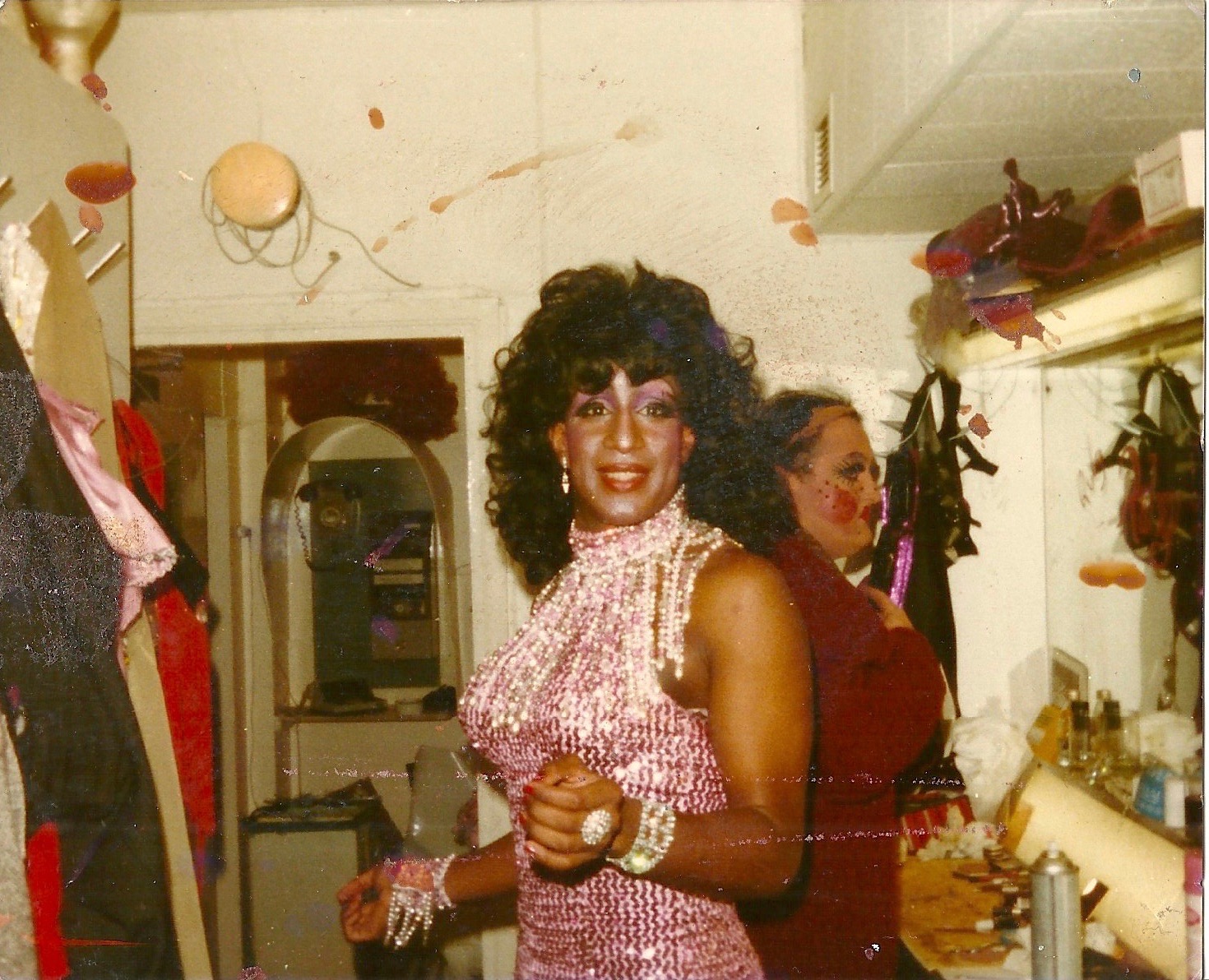
There’s a picture of me with Ruby Venezuela in the background, Ruby being done up as Annie. In other words she has small make up, very red circles for cheeks and little brown circles for freckles which she’s applying. And in the foreground is me in a pink dress with black hair after I’ve just done ‘I’m telling you I’m not going’ from Dreamgirls, which was my big number.
While we were doing La Vie en Rose, Paul Raymond came into our dressing room and said, “I’m opening a new bar called The Piano Bar and I want you to go and visit it.” It wasn’t like, “Oh, please go…” It was, “I want you to go and VISIT IT.” As in ALL the staff go to this, because it is my new venture.
And we went along to The Piano Bar and then, of course, we liked it because it was a piano with bar. And the colour and the layout worked perfectly. Red and gold, it’s very bordello, but at the same time it’s very inviting. And it’s plush. And because of that and the banquettes all the way round, when it opened everyone went in there. So you’d get rent boys, and you’d get the punters and you’d get drag artists and you’d get girls from the Revue Bar, because Paul Raymond sort of said, “Go down and visit.” And we all went down and we met and we had wonderful times. And sometimes we ended up going to later clubs afterwards.
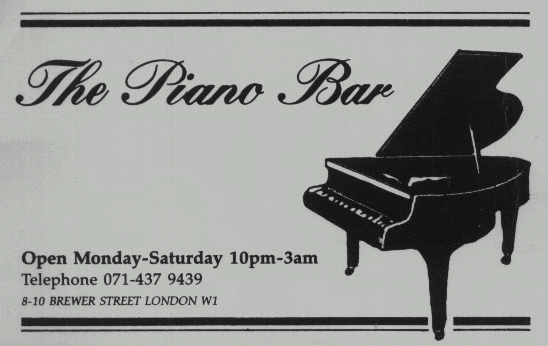
Lesley Lewis: We’d go to The Piano Bar. And all the drag queens would come in and sing and do their act. It was fantastic. Madame Jo Jo would come in and sing. And lots of stars would come in and do a number. Oh, it was all sorts. And everybody used to go there when they finished work. Everyone who ran the pubs and clubs. It was just enormous fun. You never knew who was going to go on next.
Carl Snitcher: That eastern side of Walker’s Court, the corner of Walker’s Court and Brewer Street, was a sprawling mass of different operations. In what is now Madame Jo Jo’s was a cinema called the Soho Cinema that showed x-rated or other movies. It used to be a nightclub for many, many years but when I joined it that’s what it was. On the corner, the right-hand corner, was a bar we started called the Piano Bar which was a gay bar. It started off as a lesbian bar called Lee and Wanda’s Piano Bar and there were so many problems with these women who used to frequent there that we changed it from a gay bar, a lesbian bar, into just a gay bar. We just took off the words Lee and Wanda.
The guy that was actually running the piano bar was a guy named John Wright named Jo Jo. And he was the most beautiful looking man, he was of Chinese extraction. Yeah, he came from Hong Kong. He was a good-looking man but he was an even better-looking woman, when he dressed as a woman. And he was the chap who was asked to run Madame Jo Jo’s – and Madame Jo Jo’s became named after the nick name he had. But that was in the early ‘80s.
And the place was absolutely packed. There were tables and chairs, the cabaret show was twice nightly. During the cabaret there was a disco, and they served food. It was extraordinary, really busy, busy, busy.
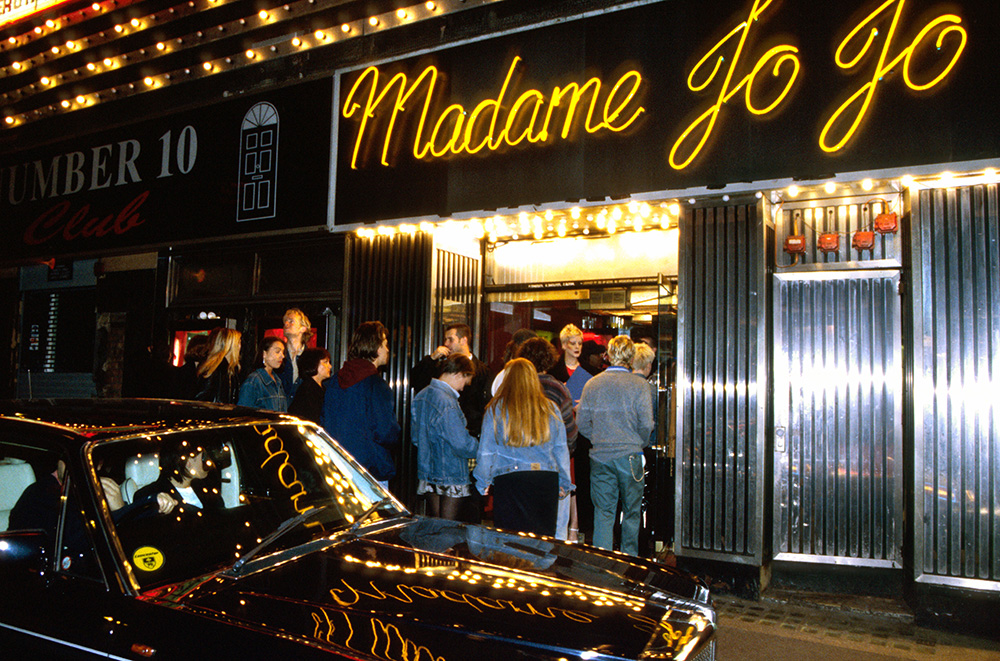
John Campbell (aka Ebbonknee): You were greeted by Tina at the top of the stairs. And then you’d walk down a flight of stairs, which were the red and gold theme again, as from The Piano Bar, as you can see from the pictures. Cabaret atmosphere rather than just an ordinary club that you went into. And because you’d get TVs, you’d get trannies, you’d get trannie admirers, you’d get drag artists, you’d get royalty, you’d get villains, you’d get stage people – because it opened after most people had done their shows. So if they’d been to The Piano Bar, when Jo Jo’s opened they decided to go down to Jo Jo’s as well. Because it meant they could carry on their evening, because normally after you’d done a show the last thing you wanted to do was to go straight to bed because you’re still normally on a buzz from doing the show.
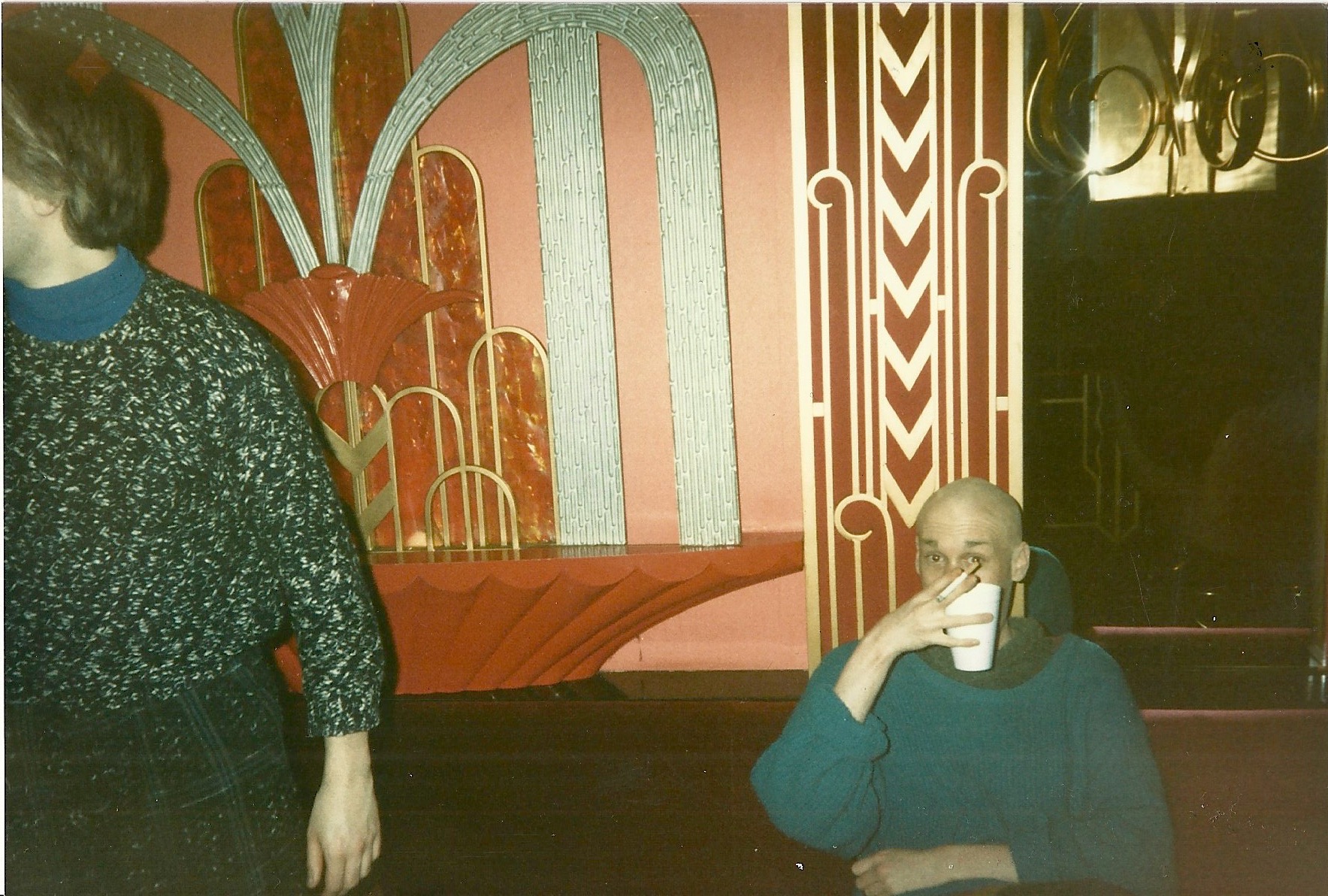
Mark Larney, stage name Minnie Diamond CBE: When I first went to Jo Jo’s, they did my make up for me and they said, “Watch what we’re doing” because it was the first and last time we’d ever get our make-up done, you got to do it yourself, and then they’d show us the Jo Jo’s tuck, because every Jo Jo’s girl was tucked the same way. So we all knew how to put things away. I used to wear a lace body that I got from Anne Summers and boots to my thigh. And that was it.
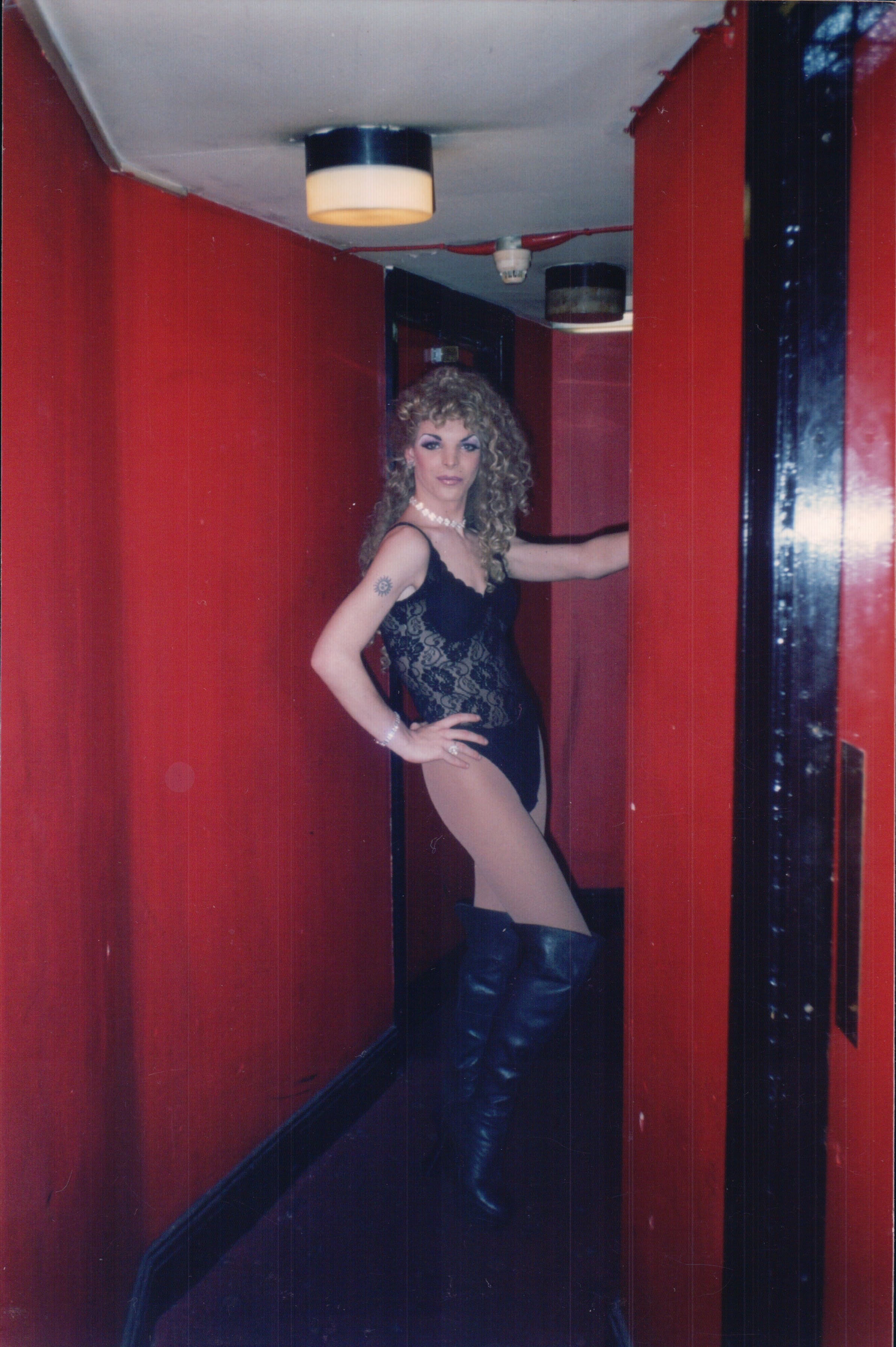
Carl Snitcher: Brian Pearce, Ruby Venezuela, was the compere, who was larger than life in those days. I remember he did an extraordinary number dressed as a bumblebee. The costumes were outrageous, the bumblebee was Ruby with his big fat tummy and exotic hat and flapping wings… it was over the top. Layers and layers of caked make up.
Gerard Simi did a lot of the choreography. He used to do the Raymond Revue Bar as well. He was gay but a very butch gay and he used to run the show with an iron rod.
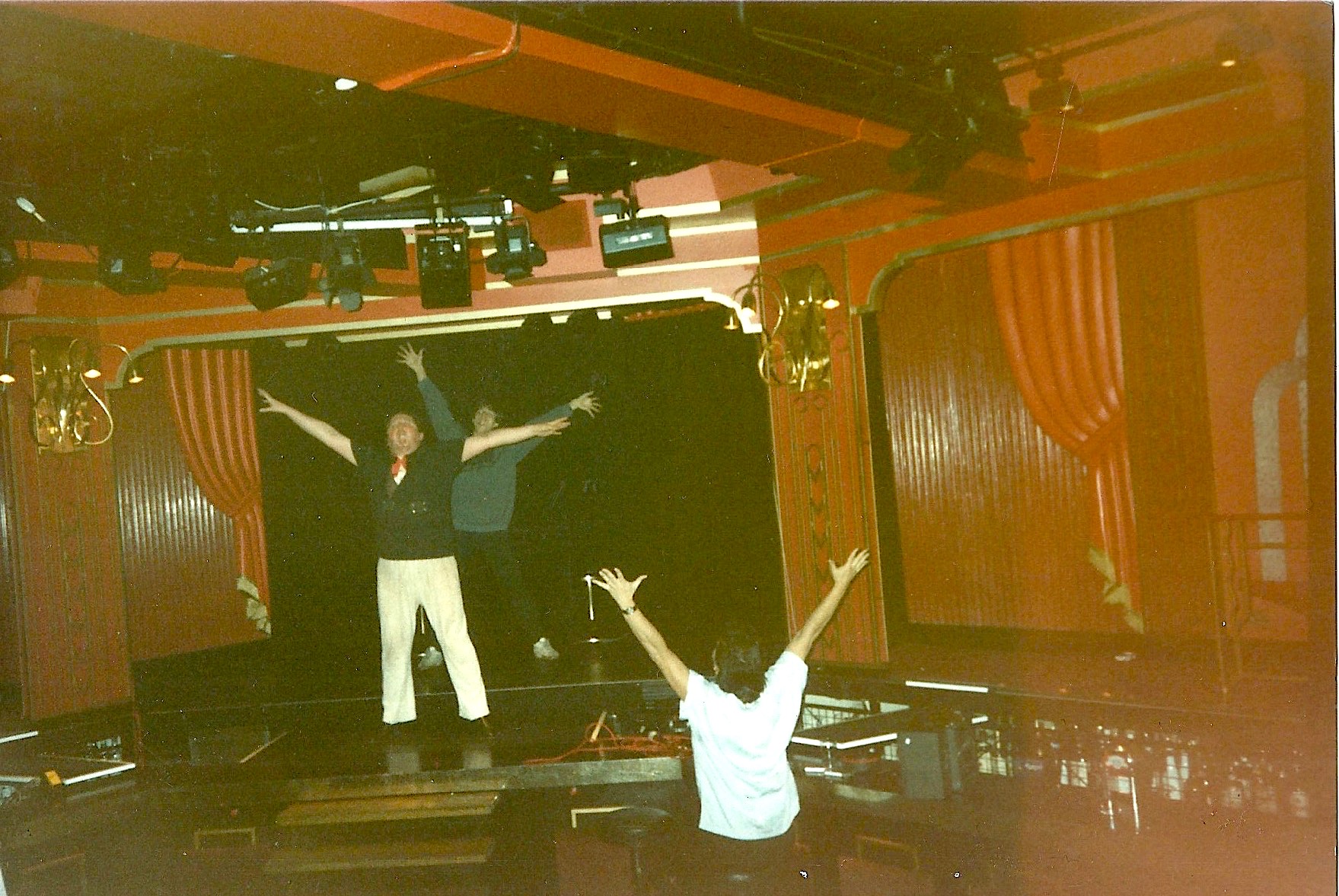
John Campbell (aka Ebbonknee): Gerard Simi – he was a perfectionist and I mean a real perfectionist to make sure that we got every single movement right. And make up wise, he always wanted it bigger than we had it. Except for Ruby whose make up was big anyway. So he went, “Just do what Ruby’s doing.” [laughter]
Mark Larney, stage name Minnie Diamond CBE: When I first met Ruby I was scared of her. This vision of green comes down the stairs at Jo Jo’s and I went, “Ohhhhh – who’s that?” and someone said to me, “That’s Ruby.” She was my drag mother. Ruby was the queen of Soho.
John Campbell (aka Ebbonknee): Areas of London had specific vibes but of all of them, I would say Soho was the one that you went, “Wow” because it was all things to everyone, providing you became immersed in the area. And if you became part of the area it was just like, yes, you live and breath Soho. It’s like an electric vibe, a sort of brilliant blue, that just goes “wooeerrsskkk” lightning bolt, that just goes wild. And it just hits all your senses and you feel it’s just like you’re tingling, that’s what Soho does.
--
You’ve been listening to the voices of Dorothea Phillips, Michael Dillon, Armin Loetscher, Tony Phillips, David Miller, Wayne Kirvin, Lesley Lewis, Carl Snitcher, John Campbell stage name Ebbonknee and Mark Larney stage name Minnie Diamond CBE, with added field recordings made by the Radio Enrichment Group at Soho Parish School. Soho Then is a photo-based podcast produced by Clare Lynch and commissioned by The Photographers’ Gallery, a Soho-based public gallery dedicated to photography. Soho Then is s financially supported by The National Lottery through the Heritage Lottery Fund and #MyWestminster Fund. With thanks to National Lottery Players.
Thanks for listening and if you enjoyed the Soho Then podcast don’t forget to like and subscribe and tell your friends to listen too.
Music credits:
La Vie En Rose, Louis Armstrong, DECCA, 1950
La Vie En Rose Grace Jones, Island Records, 1977
Jennifer Hudson - And I am Telling you from musical Dream Girls, written by Tom Eyen; Henry Krieger, Columbia, 2006
Marlene Dietrich "Kismet", 1944
Malcolm Lockyer, Suite from Secrets of a Windmill Girl, 1966
The Shadows, Dance on, Columbia, 1962
Divine, You think you're a man, Proto, 1984
Vico Torriani - Alles Fährt Ski, DECCA 1964